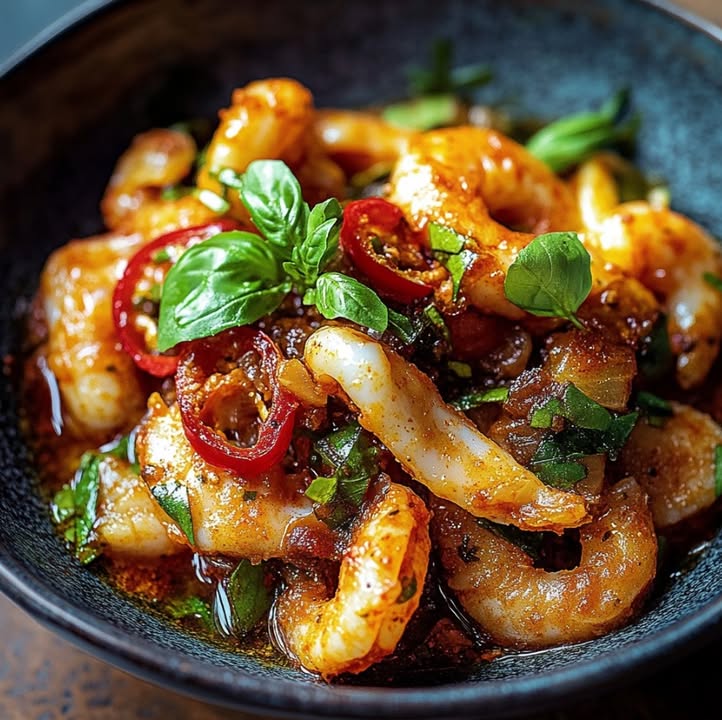
Spicy Thai Squid: A Flavor Explosion You’ll Love
Picture this: it’s a busy weeknight, and you’re craving something that feels exotic yet easy to whip up. That’s when I discovered Spicy Thai Squid with Fresh Basil and Golden Mushrooms. This dish is my go-to for quick dinners because it’s ready in 30 minutes and packs a punch of bold Thai flavors. The first time I made it, my kitchen smelled like a street food stall in Bangkok—citrusy, spicy, and aromatic all at once. It was love at first bite!
A Little Taste of Thailand
This recipe draws inspiration from classic Thai street food. Spicy Thai squid dishes are a staple in Thailand, often served sizzling hot with fresh herbs and crispy veggies. What makes this version special is the addition of golden mushrooms and fragrant Thai basil. These ingredients bring a balance of earthiness and freshness that elevates the dish. I tested this recipe after a friend mentioned how much she missed Thai cuisine while living abroad. One bite, and she said it transported her straight back to her favorite night market.
Why You’ll Fall for This Recipe
If you’re looking for a dish that’s both simple and impressive, this is it. The combination of tender squid, fiery chilies, and sweet-savory sauce will have your taste buds dancing. Plus, it’s versatile enough for a casual dinner or a fancy meal with friends. And don’t worry if you’re not a pro in the kitchen—this recipe is beginner-friendly and comes together quickly.
Perfect Times to Make Spicy Thai Squid
This dish shines on busy weeknights when you need something fast but satisfying. It’s also a great choice for themed dinner parties or date nights. Imagine serving this vibrant dish alongside a glass of chilled white wine or a refreshing Thai iced tea. Your guests will be impressed by the bold flavors and your “chef-like” skills!
What You’ll Need
- 2–3 tablespoons neutral oil (sunflower, grapeseed, or peanut)
- 2 shallots, finely sliced
- 6 garlic cloves, minced
- 3 red Thai chilies, finely chopped (adjust to taste)
- 100g maitake mushrooms, shredded (or shiitake/white mushrooms, sliced)
- 450g cleaned squid, cut into rings and tentacles
- 2 teaspoons fish sauce
- 2 tablespoons soy sauce
- 1 tablespoon brown sugar
- 1 teaspoon toasted sesame oil
- 60ml water
- 1 cup fresh Thai basil leaves
Ingredient Substitutions
If you can’t find Thai basil, regular basil works in a pinch, though the flavor will be slightly different. Swap out squid for shrimp or chicken if seafood isn’t your thing. For a vegetarian version, use tofu instead of squid and replace fish sauce with soy sauce or tamari. Don’t stress about exact measurements—Thai cooking is forgiving and flexible!
Step 1: Prep the Aromatics
Heat 1 tablespoon of oil in a large skillet over medium-high heat. Add the sliced shallots and sauté for 3–4 minutes until golden. Toss in the minced garlic and chopped chilies, letting them sizzle for another minute. The aroma will hit you instantly—it’s like a burst of sunshine in your kitchen! Once fragrant, transfer this mixture to a bowl and set aside. Pro tip: Keep an eye on the garlic so it doesn’t burn; burnt garlic can ruin the dish.
Step 2: Cook the Mushrooms
Add a splash more oil to the pan if needed. Throw in the mushrooms and cook them on high heat for 3–4 minutes until they turn golden and slightly crispy. Mushrooms soak up flavors beautifully, so don’t skimp on browning them. Once done, remove them and add them to the bowl with the aromatics.
Step 3: Sauté the Squid
Now for the star of the show—the squid! Arrange the squid rings in a single layer in the hot pan. If necessary, drizzle in a bit more oil. Cook them for about 3 minutes, flipping occasionally, until they develop a light sear. Overcooking squid can make it rubbery, so keep it short and sweet. Repeat with the tentacles if needed, then set them aside with the other components.
Step 4: Make the Sauce
In the same pan, combine fish sauce, soy sauce, brown sugar, toasted sesame oil, and water. Stir everything together over medium heat, bringing it to a gentle boil. Let it simmer for 2 minutes to thicken slightly. This sauce is the soul of the dish, balancing salty, sweet, and umami notes perfectly. Pro tip: Taste as you go and adjust the seasoning to match your preferences.
Step 5: Bring It All Together
Return the squid, mushrooms, and aromatics to the pan. Stir everything to coat evenly with the sauce. Finally, toss in the Thai basil leaves and give it a quick stir for 1–2 minutes until the leaves wilt slightly. The basil adds a peppery, citrusy note that ties the dish together. Serve immediately for maximum flavor impact.
Chef’s Tip
To take this dish to the next level, sprinkle some toasted sesame seeds or crushed peanuts on top before serving. It adds texture and a nutty crunch that complements the soft squid and chewy mushrooms.
Timing Breakdown
- Prep Time: 15 minutes
- Cooking Time: 15 minutes
- Total Time: 30 minutes
Chef’s Secret
The key to perfect squid is high heat and minimal cooking time. Squid cooks incredibly fast, so trust your instincts and pull it off the heat as soon as it changes color and firms up. Overcooked squid becomes tough and chewy, which no one wants!
An Interesting Fact
Did you know that Thai basil has a stronger, spicier flavor than regular basil? Its distinct taste pairs beautifully with seafood and spicy dishes, making it a staple in Southeast Asian cuisine.
Necessary Equipment
- Large skillet or wok
- Wooden spoon or spatula
- Sharp knife for slicing
- Cutting board
- Measuring spoons and cups
How to Store Leftovers
Leftover Spicy Thai Squid should be stored in an airtight container in the fridge. It keeps well for up to two days. Reheat gently in a skillet to preserve the squid’s texture. Avoid microwaving, as it can make the squid rubbery. If you want to freeze it, skip adding the basil until reheating, as frozen basil tends to lose its vibrant flavor.
For best results, portion out servings before storing. Smaller portions reheat faster and more evenly. Always check for any off smells or tastes before consuming leftovers.
Lastly, consider pairing leftover squid with noodles or rice for a completely new dish. Simply toss it with cooked spaghetti and a splash of soy sauce for a quick Asian-inspired pasta meal.
Tips and Advice
- Use fresh ingredients whenever possible. Fresh herbs and vegetables make a noticeable difference in flavor.
- If you’re unsure about spice levels, start with fewer chilies and adjust later.
- Pat the squid dry before cooking to prevent excess moisture from steaming it instead of searing.
Presentation Ideas
- Serve the dish on a bed of fluffy jasmine rice for a restaurant-quality look.
- Garnish with lime wedges and extra basil leaves for a pop of color.
- Drizzle a little extra sesame oil on top for shine and added aroma.
Healthier Alternatives
Here are six ways to tweak this recipe for a healthier twist:
- Low-Sodium Option: Use low-sodium soy sauce and reduce the amount of salt.
- Vegetarian Version: Substitute tofu or tempeh for squid and swap fish sauce with tamari.
- Keto-Friendly Dish: Skip the rice and serve the squid over cauliflower rice.
- Gluten-Free Adaptation: Choose gluten-free soy sauce or tamari.
- Less Oil: Use a nonstick pan to minimize the amount of oil required.
- Extra Veggies: Add bell peppers, snap peas, or baby corn for more nutrition.
Mistake 1: Overcooking the Squid
Overcooked squid turns rubbery and loses its delicate texture. This happens when people leave it on the heat too long, thinking it needs more time. To avoid this, cook the squid just until it’s opaque and firm, usually no more than 3 minutes. Pro tip: Remove it from the pan as soon as it curls tightly.
Mistake 2: Skipping the Browning Step
Browning the shallots, garlic, and mushrooms creates layers of flavor. Some rush through this step, but patience pays off. Take the time to caramelize these ingredients properly—it makes the dish unforgettable.
Mistake 3: Using Dried Basil Instead of Fresh
Fresh Thai basil is essential for authentic flavor. Dried basil lacks the bright, peppery notes that define this dish. If you can’t find Thai basil, opt for regular fresh basil rather than dried.
Mistake 4: Not Adjusting Seasoning
Taste as you cook! Every brand of fish sauce and soy sauce varies in saltiness. Failing to adjust seasoning can result in a bland or overly salty dish. Trust your palate and tweak accordingly.
Mistake 5: Adding Basil Too Early
Thai basil wilts quickly and loses its vibrancy if cooked for too long. Add it right at the end, giving it just enough heat to soften without turning mushy.
FAQs
Can I use frozen squid?
Absolutely! Just thaw it completely and pat it dry before cooking. Frozen squid works just as well as fresh, provided it’s handled correctly.
Is this dish very spicy?
It depends on your tolerance. You can control the heat by adjusting the number of chilies. Start small and increase gradually.
Where can I buy Thai basil?
Check your local Asian grocery store or farmers’ market. Many larger supermarkets also carry it in their fresh herb section.
Can I make this ahead of time?
While it’s best served fresh, you can prep the ingredients ahead of time. Assemble and cook just before serving for optimal texture.
What sides pair well with this dish?
Jasmine rice, steamed broccoli, or a simple cucumber salad complement the bold flavors nicely.
Can I double the recipe?
Yes, but ensure your pan is large enough to avoid overcrowding. Cook in batches if needed.
Does this dish reheat well?
It reheats decently, but the squid may become slightly tougher. Reheat gently in a skillet for best results.
Can I substitute the mushrooms?
Of course! Try oyster mushrooms, enoki, or even portobellos for a different texture.
Is this dish gluten-free?
Yes, as long as you use gluten-free soy sauce or tamari.
How do I clean squid properly?
Rinse the squid under cold water, removing the head, ink sac, and cartilage. Cut the body into rings and separate the tentacles. Pat dry before cooking.
Final Thoughts
Spicy Thai Squid with Fresh Basil and Golden Mushrooms is a dish that proves big flavors don’t require big effort. Whether you’re a seasoned home cook or a beginner, this recipe will impress anyone lucky enough to try it. So grab your skillet, embrace the sizzle, and let this dish transport you to the bustling streets of Thailand—one spicy, fragrant bite at a time.

Spicy Thai Squid
Ingredients
Equipment
Method
- Heat 1 tablespoon of oil in a large skillet over medium-high heat and sauté the sliced shallots for 3–4 minutes until golden.
- Add minced garlic and chopped chilies, let them sizzle for another minute, then transfer to a bowl and set aside.
- Add more oil to the pan if needed, and cook the mushrooms on high heat for 3–4 minutes until golden and slightly crispy, then add to the bowl with aromatics.
- Arrange the squid rings in a single layer in the hot pan, cook for about 3 minutes until lightly seared, then set aside with other ingredients.
- In the same pan, combine fish sauce, soy sauce, brown sugar, toasted sesame oil, and water, stirring over medium heat until it thickens slightly.
- Return the squid, mushrooms, and aromatics to the pan, coat evenly with the sauce, and toss in the Thai basil leaves, cooking for a quick 1–2 minutes until wilted.
